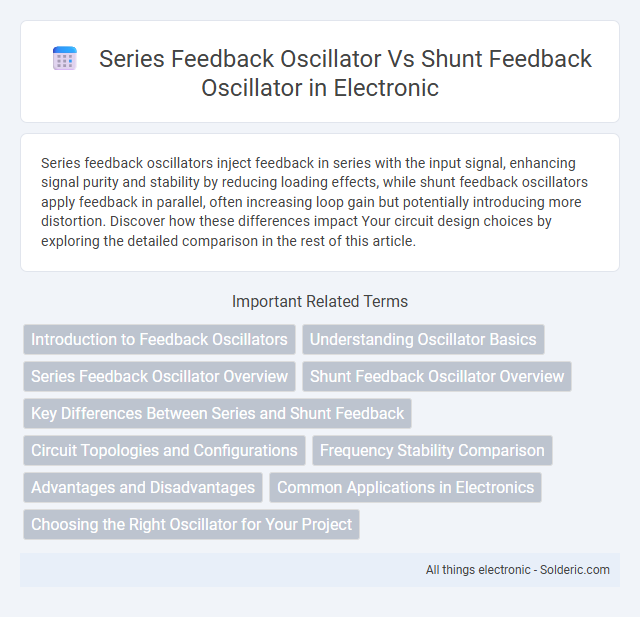Series feedback oscillators inject feedback in series with the input signal, enhancing signal purity and stability by reducing loading effects, while shunt feedback oscillators apply feedback in parallel, often increasing loop gain but potentially introducing more distortion. Discover how these differences impact Your circuit design choices by exploring the detailed comparison in the rest of this article.
Comparison Table
| Feature | Series Feedback Oscillator | Shunt Feedback Oscillator |
|---|---|---|
| Feedback Connection | Feedback network connected in series with input. | Feedback network connected in shunt (parallel) with input. |
| Input Impedance | High input impedance. | Low input impedance. |
| Output Impedance | Low output impedance. | High output impedance. |
| Application | Voltage-mode signal control; ideal for voltage amplifiers. | Current-mode signal control; suited for current amplifiers. |
| Stability | Generally more stable; less affected by load variations. | Less stable; sensitive to impedance changes. |
| Typical Usage | Oscillators requiring low distortion and stable amplitude. | Oscillators used where current feedback is preferred. |
Introduction to Feedback Oscillators
Feedback oscillators generate continuous wave signals by feeding a portion of the output back to the input, creating a loop that sustains oscillations. In a series feedback oscillator, the feedback network is connected in series with the input, controlling the input signal current and enhancing loop gain stability. Your choice between series and shunt feedback oscillators depends on desired input impedance and frequency response, as shunt feedback connects parallel to the input, influencing voltage levels and noise characteristics.
Understanding Oscillator Basics
Series feedback oscillators use a feedback network connected in series with the input, promoting stability and high-frequency operation by controlling loop gain through voltage sampling. Shunt feedback oscillators employ a feedback network connected in parallel, favoring current feedback, which can simplify impedance matching and improve linearity in certain circuits. Your choice between these oscillator types depends on the desired frequency response, gain stability, and application-specific requirements.
Series Feedback Oscillator Overview
A series feedback oscillator uses a feedback network connected in series with the input signal, which improves signal stability and reduces distortion. This configuration ensures that the feedback voltage is proportionally related to the output current, enhancing the oscillator's precision and frequency control. Your design will benefit from the series feedback oscillator's ability to maintain consistent oscillations with minimal amplitude variations.
Shunt Feedback Oscillator Overview
Shunt feedback oscillators leverage a feedback network that samples voltage in parallel with the input signal, enabling stable oscillation conditions with minimal phase shift and amplitude distortion. This configuration excels in high-frequency applications due to its inherent low noise figure and improved gain control, enhancing overall oscillator performance. Compared to series feedback oscillators, shunt feedback designs offer easier impedance matching and greater flexibility in tuning frequency stability.
Key Differences Between Series and Shunt Feedback
Series feedback oscillators feed a portion of the output back in series with the input signal, enhancing voltage gain stability and reducing input impedance. Shunt feedback oscillators return the feedback signal in parallel (shunt) with the input, primarily affecting current gain and increasing input impedance. Your choice between these configurations depends on the desired input/output impedance characteristics and the specific application requirements.
Circuit Topologies and Configurations
Series feedback oscillators employ a feedback network connected in series with the input signal, integrating the output voltage directly into the input loop, which enhances voltage gain stability. In contrast, shunt feedback oscillators use a feedback path connected in parallel (shunt) with the input, often injecting current feedback that stabilizes input impedance and controls oscillation frequency. The fundamental difference in their circuit topologies lies in how the feedback is applied--series feedback alters signal voltage linearly in the input path, whereas shunt feedback modifies input current, resulting in distinct loop gain and phase characteristics.
Frequency Stability Comparison
Series feedback oscillators generally provide higher frequency stability due to the direct control of the feedback signal through the series connection, minimizing phase noise and distortion. Shunt feedback oscillators, while offering simpler circuit configurations, often exhibit lower frequency stability because the feedback signal is applied in parallel, which can introduce additional loading effects and variations. Precise frequency control in series feedback designs makes them preferable for high-stability applications such as RF communication and precision measurement instruments.
Advantages and Disadvantages
Series feedback oscillators provide better stability and improved linearity due to their series connection with the input, making them ideal for low-noise applications. However, they can suffer from reduced gain and potential loading effects on the input signal. In contrast, shunt feedback oscillators offer higher gain and less input loading, but they may exhibit increased distortion and sensitivity to component variations, impacting overall oscillator performance.
Common Applications in Electronics
Series feedback oscillators are commonly used in high-frequency applications such as RF signal generation and communication systems due to their improved frequency stability and reduced distortion. Shunt feedback oscillators find frequent use in audio frequency generation and low-frequency signal processing circuits because of their simpler design and ease of gain control. Both types serve critical roles in signal synthesis, with series feedback oscillators favored for precision tasks and shunt feedback for general-purpose oscillation.
Choosing the Right Oscillator for Your Project
Selecting between series feedback oscillators and shunt feedback oscillators depends on the desired frequency stability and output waveform quality. Series feedback oscillators excel in applications requiring high-frequency accuracy and low distortion, making them ideal for RF signal generation and precision timing circuits. Shunt feedback oscillators offer simpler design and better amplitude control, which suits audio frequency applications and situations where ease of implementation is a priority.
series feedback oscillator vs shunt feedback oscillator Infographic

 solderic.com
solderic.com